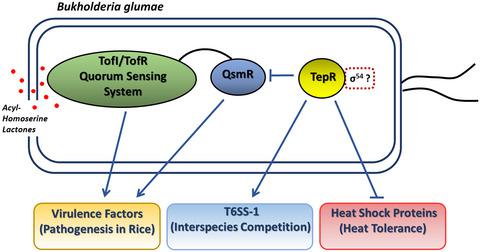当前位置:
X-MOL 学术
›
Mol. Plant Pathol.
›
论文详情
Our official English website, www.x-mol.net, welcomes your feedback! (Note: you will need to create a separate account there.)
tepR encoding a bacterial enhancer-binding protein orchestrates the virulence and interspecies competition of Burkholderia glumae through qsmR and a type VI secretion system.
Molecular Plant Pathology ( IF 4.9 ) Pub Date : 2020-07-01 , DOI: 10.1111/mpp.12947 Jingyu Peng 1 , Tiago Lelis 1, 2 , Ruoxi Chen 1 , Inderjit Barphagha 1 , Surendra Osti 1 , Jong Hyun Ham 1
Molecular Plant Pathology ( IF 4.9 ) Pub Date : 2020-07-01 , DOI: 10.1111/mpp.12947 Jingyu Peng 1 , Tiago Lelis 1, 2 , Ruoxi Chen 1 , Inderjit Barphagha 1 , Surendra Osti 1 , Jong Hyun Ham 1
Affiliation

|
The pathogenesis of the rice pathogenic bacterium Burkholderia glumae is under the tight regulation of the tofI/tofR quorum‐sensing (QS) system. tepR, encoding a group I bacterial enhancer‐binding protein, negatively regulates the production of toxoflavin, the phytotoxin acting as a major virulence factor in B. glumae. In this study, through a transcriptomic analysis, we identified the genes that were modulated by tepR and/or the tofI/tofR QS system. More than half of the differentially expressed genes, including the genes for the biosynthesis and transport of toxoflavin, were significantly more highly expressed in the ΔtepR mutant but less expressed in the ΔtofI‐tofR (tofI/tofR QS‐defective) mutant. In consonance with the transcriptome data, other virulence‐related functions of B. glumae, extracellular protease activity and flagellum‐dependent motility, were also negatively regulated by tepR, and this negative regulatory function of tepR was dependent on the IclR‐type transcriptional regulator gene qsmR. Likewise, the ΔtepR mutant exhibited a higher level of heat tolerance in congruence with the higher transcription levels of heat shock protein genes in the mutant. Interestingly, tepR also exhibited its positive regulatory function on a previously uncharacterized type VI secretion system (denoted as BgT6SS‐1). The survival of the both ΔtepR and ΔtssD (BgT6SS‐1‐defective) mutants was significantly compromised compared to the wild‐type parent strain 336gr‐1 in the presence of the natural rice‐inhabiting bacterium, Pantoea sp. RSPAM1. Taken together, this study revealed pivotal regulatory roles of tepR in orchestrating multiple biological functions of B. glumae, including pathogenesis, heat tolerance, and bacterial interspecies competition.
中文翻译:

编码细菌增强子结合蛋白的tepR通过qsmR和VI型分泌系统来协调伯克霍尔德氏菌的毒力和种间竞争。
水稻致病性小球藻伯克霍尔德氏菌的发病机理受tofI / tofR群体感应(QS)系统的严格调控。特尔,编码I组细菌增强子结合蛋白,负调节生产toxoflavin的,作为一个主要毒力因子的植物毒素B. glumae。在这项研究中,通过转录组分析,我们鉴定了由tepR和/或tofI / tofR QS系统调节的基因。超过一半的差异表达基因,包括用于毒素合成和运输黄素的基因,在Δ中的表达明显更高。tepR突变体,但在ΔtofI-tofR(tofI / tofR QS缺陷型)突变体中表达较少。与转录数据,其它的毒力相关的功能相一致B. glumae,胞外蛋白酶活性和鞭毛依赖性蠕动,也负面调控特尔,以及该负调节功能特尔是依赖于ICLR型转录调节基因qsmR。同样地,ΔtepR突变体与突变体中热休克蛋白基因的较高转录水平一致,表现出较高水平的耐热性。有趣的是,tepR在以前未表征的VI型分泌系统(称为BgT6SS-1)上也表现出了积极的调节作用。在存在天然水稻的细菌Pantoea sp。存在下,与野生型亲本菌株336gr-1相比,ΔtepR和ΔtssD(BgT6SS-1缺陷型)突变体的存活率均显着降低。RSPAM1。两者合计,这项研究揭示了tepR在协调B. glumae的多种生物学功能(包括发病机理,耐热性和细菌种间竞争)中的关键调节作用。
更新日期:2020-07-01
中文翻译:

编码细菌增强子结合蛋白的tepR通过qsmR和VI型分泌系统来协调伯克霍尔德氏菌的毒力和种间竞争。
水稻致病性小球藻伯克霍尔德氏菌的发病机理受tofI / tofR群体感应(QS)系统的严格调控。特尔,编码I组细菌增强子结合蛋白,负调节生产toxoflavin的,作为一个主要毒力因子的植物毒素B. glumae。在这项研究中,通过转录组分析,我们鉴定了由tepR和/或tofI / tofR QS系统调节的基因。超过一半的差异表达基因,包括用于毒素合成和运输黄素的基因,在Δ中的表达明显更高。tepR突变体,但在ΔtofI-tofR(tofI / tofR QS缺陷型)突变体中表达较少。与转录数据,其它的毒力相关的功能相一致B. glumae,胞外蛋白酶活性和鞭毛依赖性蠕动,也负面调控特尔,以及该负调节功能特尔是依赖于ICLR型转录调节基因qsmR。同样地,ΔtepR突变体与突变体中热休克蛋白基因的较高转录水平一致,表现出较高水平的耐热性。有趣的是,tepR在以前未表征的VI型分泌系统(称为BgT6SS-1)上也表现出了积极的调节作用。在存在天然水稻的细菌Pantoea sp。存在下,与野生型亲本菌株336gr-1相比,ΔtepR和ΔtssD(BgT6SS-1缺陷型)突变体的存活率均显着降低。RSPAM1。两者合计,这项研究揭示了tepR在协调B. glumae的多种生物学功能(包括发病机理,耐热性和细菌种间竞争)中的关键调节作用。


























 京公网安备 11010802027423号
京公网安备 11010802027423号